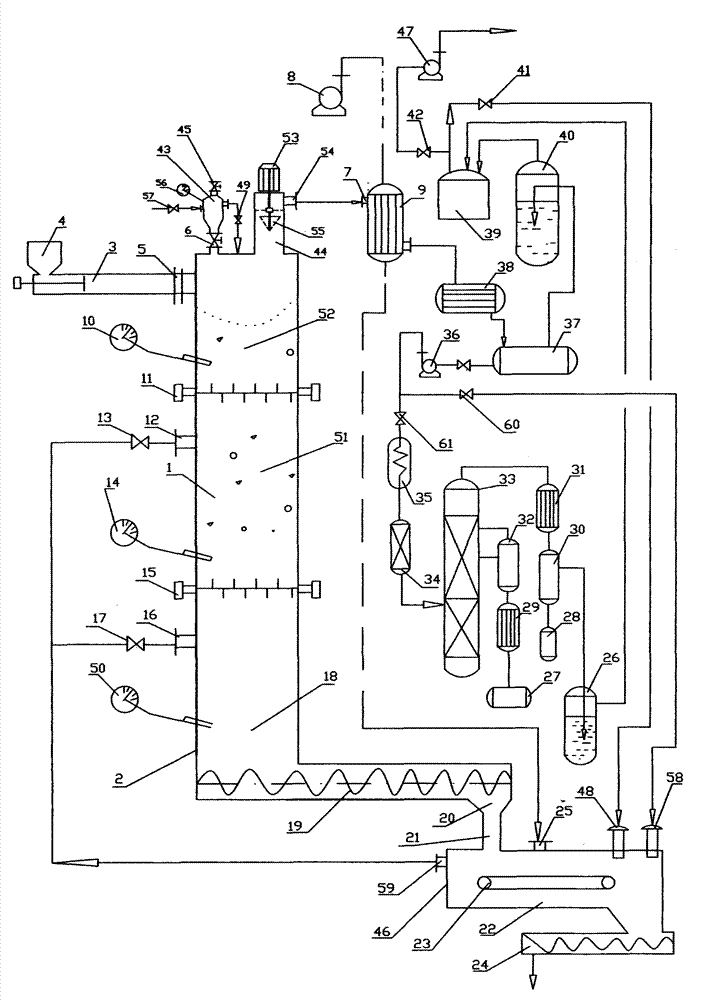[0003] The composition of domestic waste is complex, and the existing domestic waste (or including
medical waste) heat treatment technology and equipment, such as gasification
incineration method, direct
incineration method, etc., all have the defect that the
tail gas contains dioxin; The organic waste is pyrolyzed in the reduction zone and cracking zone at 500-900°C into a low calorific value (5000KJ / Nm 3 left and right) gas (CO, CH 4 、C 2 -C 5 , N 2 、H 2 , CO 2 ); At present, the heat
utilization rate of the most advanced gas-fired power generation in the world is at most 33%, and the remaining heat is lost from the high-temperature
flue gas discharged from the gas-fired generator, while the direct incineration method uses the organic waste in domestic waste All incinerated to ashes, the high-temperature
flue gas produced is used as the heat source of the steam boiler to generate
water vapor, while the heat utilization conversion rate of the steam-driven
steam turbine generator is only about 22%, and a large amount of energy is lost and cannot be recycled, resulting in garbage The
resource utilization rate is low;
[0004] The prior art has disclosed some technical schemes to solve this problem; the inventor disclosed a method for producing hydrocarbons from domestic garbage and / or organic waste in USP6,133,491, USP6,270,630B1 and ZL98117823.5 and equipment, discloses the first-stage and second-stage thermal cracking and catalytic cracking treatment methods for the same
raw material using steel reaction equipment at two different temperatures, low and high; however, to make various organic substances in domestic waste Complete
decomposition must reach a high temperature environment of 800-1100°C, but a single steel rotary reactor is easily deformed and cannot be rotated in a high temperature environment for a long time, and the
cracking reaction cannot be carried out to the end, resulting in a certain amount of
organic matter remaining in the residue of the
cracking reaction.
Macromolecular substances cannot be completely decomposed, and the thorough reduction and harmlessness of domestic waste cannot be implemented; the inventor disclosed a method for
continuous treatment of domestic waste in ZL200710130127.5. The garbage is transported to the closed
pyrolysis equipment, and the steel equipment is heated indirectly under anaerobic conditions to generate thermal cracking of the raw materials; however, the
thermal efficiency of indirect heating is low, the
energy consumption is high, the
pyrolysis time is long, and the cost of garbage treatment is high. Knownly, a single domestic waste incinerator is usually horizontal or vertical, such as Martin incinerator, fluidized incinerator, reciprocating grate incinerator, various vertical or horizontal incinerators, and
fluidized bed incinerators. ...and so on, the furnace body is huge, the heat dissipation area is large, the comprehensive
utilization rate of heat is low, and the investment is large, the profit return rate is low, it is not suitable for economically underdeveloped countries and small and medium-sized towns, and the promotion and application value is low; With the transmission of the incineration grate, in the process of moving domestic waste from the
drying area (low-medium temperature area) to the
combustion area (high-temperature area), it must pass through a temperature range of 500-700 ° C. In this temperature range, the waste contained in the domestic waste
Chlorine-containing substances such as salt or
chlorine-containing plastics (PVC) and C and H elements and
oxygen O in the air 2 Combined into harmful dioxins (PCDFs), it has caused serious
pollution and harm to the environment, which is an unavoidable objective fact
In ZL201120082883.7, "A Garbage
Dry Distillation Pyrolysis and Gasification Device Effectively Containing Dioxins" is disclosed, and in ZL201110073735.3, "A Comprehensive
Waste Treatment and Utilization Method Effectively Containing Dioxins" is disclosed, The
dry distillation or
decomposition equipment of the above two kinds of domestic wastes all belong to the conventional gasification incinerator. "Gasification-incineration" combined
biomass gas production furnace, domestic waste raw materials are added into the furnace from the upper part of the furnace body, and continuously move down until the bottom of the furnace turns into ashes, and domestic waste moves down to the cracking area (500- 700°C) or reduction zone (about 850°C), affected by the
eddy current or kick flow of the upwardly flowing air, some
chlorine-containing substances such as salt or
chlorine-containing plastics contained in domestic garbage will react with
oxygen in the air, which will inevitably A considerable amount of dioxins (PCDFs) are produced objectively and objectively; especially, if this kind of gasification incinerator is used as a
pyrolysis device for domestic waste, a large amount of recyclable energy contained in domestic waste can produce high-value Commodity organic hydrocarbons (such as plastic or rubber) are burned in the reduction zone and
combustion zone at a high temperature of 850-1100 °C, and only a small part is converted into a low calorific value
combustible gas containing a large amount of 40-50% (V%)
nitrogen , cannot better implement the
resource utilization of domestic waste;
 Login to View More
Login to View More 

